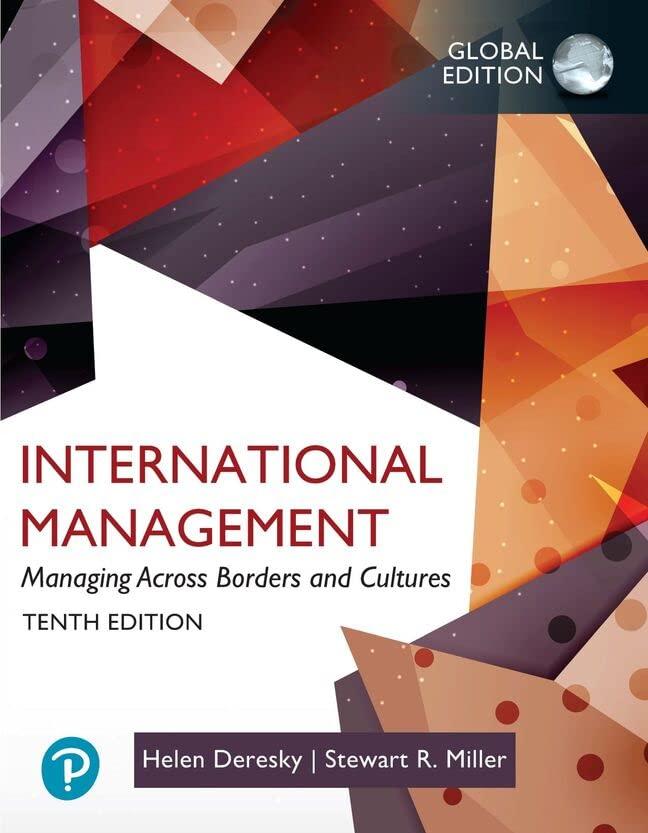In March 2017, a federal judge in California dismissed a long-running (12-year) class action lawsuit against Nestl
Question:
In March 2017, a federal judge in California dismissed a long-running (12-year) class action lawsuit against Nestlé SA
(Nestlé) and two more companies over claims the global chocolate manufacturer facilitated the use of forced child labor in West Africa. Nestlé, one of the world’s largest food processing companies, had been grappling with accusations of aiding and abetting child slavery on cocoa plantations in Ivory Coast 2 for more than a decade.
Earlier in 2015, Nestlé surprised many by admitting that it had found forced labor in its seafood supply chain in Thailand.
Magdi Batato (Batato), Executive Vice President and Head of Operations at Nestlé, self-reported that Nestle had uncovered child labor exploitation on fishing boats in Thailand that supplied its factories. He reported details of the investigation and also initiated a detailed action plan on how it intended to tackle the issue.
The news generated a mixed response from industry observers.
Hailing Nestlé’s honesty, Brian Griffin, CEO of digital marketing agency Vero PR, said, “First of all, what Nestlé did was brave, and from a moral perspective, they did the right thing to let stakeholders know about this issue. They will feel some pain from this initially, particularly from a consumer standpoint, and it’s not hard to imagine that sales of seafood products may decline. There is no question that the issue must be cleaned up, and that it must happen now. We should appreciate what Nestlé has done to bring even more attention to the issue.”3 However, Nestlé’s critics contended that the company had done this only to fend off growing criticism against it. It had admitted to slavery in seafood, a lowprofit area of the company’s business, while not doing enough to tackle this problem in its lucrative chocolate business.
In September 2015, three class action lawsuits brought in by consumers in California accused Nestlé of turning a blind eye to human rights abuses by cocoa suppliers in West Africa while falsely portraying itself as a socially and ethically responsible company. Nestlé said it was committed to tackling child labor in its cocoa supply chain, and had been taking action to address the issue which included increasing access to education, stepping up systems of age verification at cocoa farms, and increasing awareness about the company’s own code of conduct. Despite Nestlé’s assurances, the use of child labor continued and became even more prevalent in its cocoa supply chains. Though Nestlé’s commitment to eliminating slavery seemed promising, lawsuits related to slavery in its core business operations questioned such promises, critics said.
The existence of modern slavery within its cocoa supply chain posed ethical and reputational risks for Nestlé. Analysts said addressing slavery would be a critical issue for the company going forward due to the complexity and limited visibility of its supply chain, its reputation for reliability among stakeholders
(customers, investors, NGOs), transparency dilemmas as well as cost and pricing pressures. However, some analysts said Nestlé being a financially sound company, it could do more to stop slave labor and take more control over its supply chain management. According to Marianne Smallwood, a diplomat for the US Agency for International Development, “In initiating the public examination of its flaws, and in working with an organization like Verite, Nestlé has already gone a more honorable and transparent route than other companies have done. But while it has taken the first step toward being a more responsible company, Nestlé’s commitment to funding a long-term strategy—and how it pushes beyond the inevitable roadblocks ahead—will determine its ultimate footprint and legacy.” 4 According to Batato, “Every reasonable person who has gone to Africa, gone to Asia, who has seen the farmers and factories, can tell you that [child labor] does exist. It is part of their life. Do we accept it? No. Are we going to stay quiet and do nothing? No. But making a big declaration that tomorrow morning we are going to see it disappear, sometimes the problem is bigger than us, bigger than a company even the size of Nestlé.” 5 Nevertheless, the critical question before him was: How to eliminate forced labor from Nestlé’s supply chains world over? Could he address the problem and bring real and sustained change in how the company’s cocoa supply chains were managed?
Background Note Nestlé, headquartered in Vevey, Switzerland, was founded in 1866. One of the leading players in the food and beverage categories, the company had a global presence and employed more than 328,000 people as of 2017. Its sales and profits for the year 2016 were CHF 89.5 billion and CHF 8.53 billion respectively........... 6
Question
1. What is modern slavery? Where does it fit in with a company’s CSR strategy?
2. What are the conditions enabling slavery in cocoa supply chains in Ivory Coast?
3. Why is tackling the issue of modern slavery so important for a company like Nestlé?
4. Investigate the existence of modern slavery in Nestlé’s supply chains and its efforts to address the issue.
5. Discuss the key challenges Nestlé faced while addressing modern slavery in its cocoa supply chain.
6. What more should Nestlé do to mitigate the risk of modern slavery in its cocoa supply chain
Step by Step Answer:

International Management Managing Across Borders And Cultures
ISBN: 9781292430362
10th Global Edition
Authors: Helen Deresky





